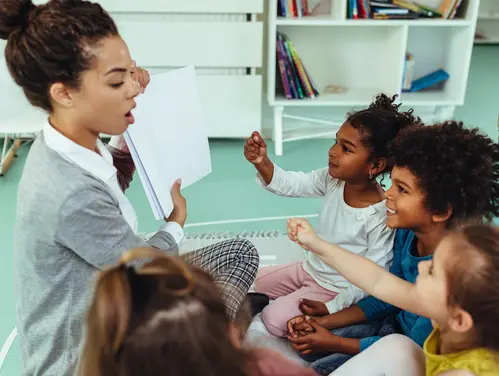Imagine starting to teach a child Spanish in preschool and, by kindergarten, classes are taught exclusively in Spanish. At Dubuque’s Our Lady of Guadalupe, they don’t have to imagine it. They are doing it. And by fifth grade, the students are fluent in both English and Spanish.
It’s business as usual for the school. Indeed, the full immersion program has been going on for 21 years. And the students who were the first to go through it?
“They are adults now and I know one is a high school Spanish teacher,” said Guadalupe Principal Kathleen Konrardy. “I have heard of many students who have pursued careers based on their having learned Spanish.”
The school teaches Spanish exclusively in kindergarten and first grade, and English is introduced in second grade. In grades 2 through 5, instruction is split evenly between English and Spanish.
“At the end of fifth grade, they are fluent in Spanish,” Konrardy said. “They can give presentations solely in Spanish. It’s incredible.”
When students head off to sixth grade at Mazzuchelli, a middle school, about 30 percent of their day is immersed in Spanish. By the time they reach Wahlert High School, students take advanced language and literature courses as well as take Advanced Placement Spanish classes.
The immersion program is so popular that there usually is a waiting list to get enrolled into the school, which has about 250 students.
According to Our Lady’s website, there are distinct benefits to immersion:
- Three decades of research and experience shows that bilingual students outperform peers on standardized verbal and math tests administered in English.
- Research confirms that immersion actually enhances a student’s English language development.
- Researchers agree that the immersion learning process fosters students with greater creativity and adaptability; more honed listening, analytical and multi-tasking skills; and higher-level critical thinking skills.
- The Center for Advanced Research and Language Acquisition at the University of Minnesota found that students in immersion programs achieve higher levels of language proficiency than students in other school-based language programs.
“Learning a world language is a 21st century skill,” said Stefanie Rosenberg Wager, the world languages consultant at the Iowa Department of Education. “Students who become proficient in a world language have a great advantage over other students in both academics and careers. Knowing a world language enables students to become active participants in a global economy.”
Konrardy said the school’s immersion program goes beyond teaching students Spanish: It opens their eyes to other cultures.
“We provide an immersion language experience for children, but to understand and really appreciate the language, we also want children to understand the cultures and traditions of people who speak Spanish, so we are very intentional about that,” she said. “Our students have celebrated Las Doce Uvas de la Suerte, Dia de las Velitas, the Feast of Our Lady of Guadalupe, Dia de los Muertos, Camino de Santiago, Las Posadas, Hispanic Heritage Month, and Los Pasos, just to name a few. We're exceptionally lucky to have teachers and staff in our building from a wide range of traditions and cultures, and that adds to the richness of the experience here at Our Lady.”
Our Lady’s bilingual staff includes three teachers who are a part of the Visiting Teachers from Spain, a program administered by the Iowa Department of Education.
Konrardy’s own two daughters went through the school.
“As a mother, I wanted them to have more opportunities in life – to be exposed to other cultures and traditions,” she said. “I wanted them to have the ability to communicate with more people and learn to appreciate the cultures that I couldn’t provide.”
Konrardy, who studied Spanish in high school and college, said she isn’t fluent in the language. But her girls?
“They spoke it better in third grade than I could,” she said.
That can lead to some uncomfortable parenting times.
“We have siblings who attend Our Lady, and we sometimes hear that the kids will speak Spanish at home,” Konrardy said. “The kids will say that their parents get annoyed when they speak with one another. I was a parent in that situation and you act like you’re annoyed, but really you are so proud they can do that.”
Is kindergarten too early to immerse a child in a foreign language? Not at all, Konrardy said.
“Children pick up on it very quickly,” she said. “Our teachers provide visuals and directions. There are a lot of supports in those first few weeks, but by the end of the first week, the students already understand basic instructions like ‘line up’ or ‘put away your books. They just catch onto it.
“And by the end of kindergarten, they are starting to speak it. Their minds are so shapeable that they are able to learn it so much easier than adults. It’s truly wonderful to see.”
Subscribe to receive email updates from the Iowa Department of Education.
